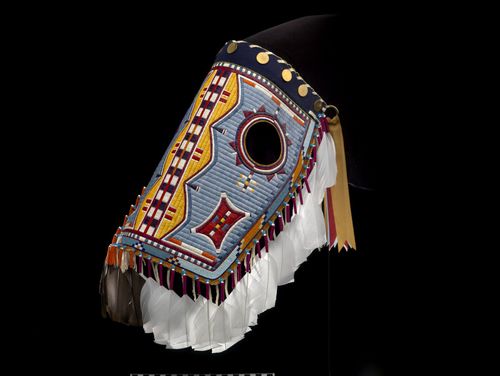| Home Kids/Big Kids Corner Index/Indians | First Posted: Oct 27, 2009 Jan 21, 2020 | |
A Song for the Horse Nation-Native American (Indian) ExhibitGalleries: A Song for the Horse Nation-Native American (Indian) Exhibit/National Indian Museum  Horse Mask
"Horse Nation" Exhibition has left New York and is now in Washington, DC. Today, October 30, 2011, my husband and I took the train down to the National Museum of the American Indian in Washington, D.C. The exhibition will be in DC until Janunary 7, 2013. We had a guided tour that is free. It was excellent. There is also a film that is part of the exhibit, also free. The exhibition is expected to tour nationally through the Smithsonian Institution Traveling Exhibition Service program (SITES). The enduring relationship between Native people and the horse is illustrated through vivid personal accounts and a spectacular array of objects in "A Song for the Horse Nation." Starting with the return of the horse to the Americas in 15th century, the exhibition traces how Native people adapted the horse into their cultural and spiritual lives and integrated it into their geographic expansion, warfare and defense. "A Song for the Horse Nation" presents 95 works, including elaborate horse trappings, clothing and photographs. Originally native to the American continent, horses became extinct but were reintroduced by the Spanish, and later by the French, English and Dutch-beginning with Columbus' second voyage in 1493. Native people soon adopted the horse and became some of the world's best horsemen. Horses were used to enhance trade, expand territory, facilitate hunting and wage war. Included in the exhibition will be a Lakota winter count (ca. 1902) by Long Soldier (Hunkpapa Lakota) that depicts when horses were first sighted by the community. Paired with the introduction of the gun, the mounted Plains warrior was a formidable fighter, upsetting old alliances among the tribes and frustrating European advances. Young men proved their valor through the horse raid, where they captured horses from enemy camps. Horses also became integrated in Native American cultural and spiritual life, representing the primary virtues of agility, grace and beauty. The exhibition includes a graceful dance stick (ca. 1890) by No Two Horns (Hunkpapa Lakota), created to honor his horse that died at the Battle of Big Horn. Later, the rise of reservations, the U.S. Army's calculated destruction of American Indian ponies and government policies that forced Native people to adopt farming eroded the day-to-day relationship of Native people and horses. Despite these changes, the horse's place in Native culture and memory remains strong. The Crow Nation has actively maintained its horse traditions, and others, like the Nez Perce, are engaged in rebuilding their horse breeds and revitalizing their equestrian way of life. The Future Generations Ride that involves Native youth has evolved from The Big Foot Memorial Ride, held as a healing ride to honor those massacred at Wounded Knee in South Dakota. "Even though the pinnacle of the horse lasted only a century, this exhibition details how Native people rapidly integrated the horse into their lifeways, quickly becoming among the best mounted soldiers in the world," said Kevin Gover (Pawnee/Comanche), director of the National Museum of the American Indian. "A Song for the Horse Nation" includes many examples of elaborate horse trappings, including a dazzling horse crupper adorned with exceptionally fine quillwork (Cree or Red River Metis, ca. 1850) and clothing adorned with images of the horse, such as a colorful Lakota baby bonnet (South Dakota or North Dakota, ca. 1900). A dazzling horse mask, with yellow, blue-gray and dark-red quillwork and trimmed with fresh-cut feathers, was created by Juanita Growing Thunder (Assiniboine/Sioux). The work is based on a 19th-century Northern Cheyenne quilled horse mask, also included in the exhibition. "A Song for the Horse Nation" was curated by museum curator Emil Her Many Horses (Oglala Lakota). An accompanying publication edited by Her Many Horses and the scholar George P. Horse Capture (A'aninin) is available at the museum's shops and the museum's Web site. For More Information:
A Song for the Horse Nation |